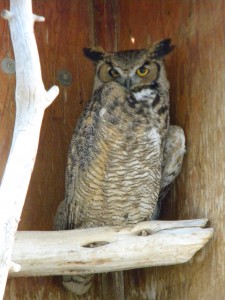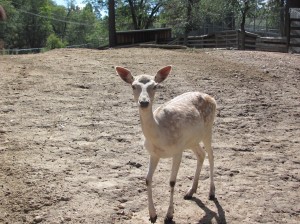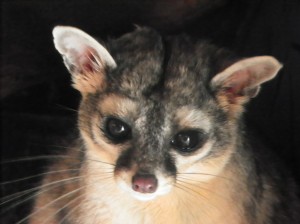Great Horned Owls at the Zoo
There are five Great Horned Owls at the Big Bear Alpine Zoo.
Boo – came in 2006 as a youngster and had a damaged right wing so he also could not be released.
Jackie O – came in 2006. She had been orphaned and was found and raised by a falconer. The falconer gave her to a rehabilitator who passed Jackie-0 on to us as she was very imprinted and loved people.
Mason
Our other three Great Horned Owls are working birds. They do on and offsite educational programs and are very comfortable in front of crowds.
Cowboy – also came to us with a severely broken wing which had to be amputated. He got his name from the fact that he would ride his perching branches like he was riding a horse.
Hootie
Description
(Bubo virginianus)
The Great Horned Owl is a very aggressive nighttime hunter and strikes from above. This is why they are sometimes called “tigers of the night.” They use their strong talons to carry animals several times heavier than they are. Great Horned owls will also kill and eat rattlesnakes.
What does the great horned owl eat?
Great Horned Owls are strictly carnivores. They eat raccoons, squirrels, rodents, falcons and sometimes other owls. Great Horned owls also eat skunks which is why they will often smell like a skunk. They also will catch cats and dogs because they have no idea they are someone’s pet. They think it’s just another prey animal in the wild.
How long do they live?
25 to 30 years in captivity.
How many Great Horned owls can be born at a time?
One to five eggs are laid but 2 are typical. Both the male and the female incubate the nest and the male hunts for food.
Where are they found?
Great Horned Owls are found from the Arctic to South America.
Interesting facts:
- The Great Horned Owl is a very aggressive nighttime hunter and strikes from above. This is why they are sometimes called “tigers of the night.”
- They use their strong talons to carry animals several times heavier than they are.
- As with most birds of prey, the male Great Horned Owl is smaller than the female. He also has a much lower pitched call.
- They sometimes swallow their prey whole and later regurgitate pellets consisting of bones, fur and other parts of their meal that they cannot digest
- Great Horned owls will also kill and eat rattlesnakes.



